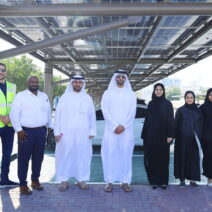Futuristic architecture has captivated the imagination of many, providing visions of a world transformed by innovative designs and sustainable technologies. Among these avant-garde concepts is the Dynamic Tower, a project that encapsulates the very essence of modern architectural ambition. This structure, designed to rotate and adapt to environmental influences, raises critical questions regarding its impact on climate change and the broader implications of such ambitious architectural endeavors in combating or exacerbating global warming.
At the heart of the Dynamic Tower’s allure lies its ability to morph. Each floor can rotate independently, allowing for personalized views and the optimization of sunlight exposure. This innovation presents a fascinating observation—people are drawn to the idea of flexibility and change in their environments, particularly in urban settings where static structures dominate. Such fascination hints at a deeper human desire for interaction with our habitats, but it also prompts an examination of whether these progressive designs genuinely contribute to sustainable living or merely serve aesthetic and experiential purposes without addressing underlying environmental concerns.
The concept of dynamic architecture, while appealing, prompts significant scrutiny when juxtaposed against fundamental principles of sustainability. An essential issue is the energy consumption associated with such complex designs. Moving parts, intricate automation systems, and advanced climate-controlled interiors could necessitate greater energy use, potentially offsetting any benefits gained from sustainable materials or passive solar design. In this regard, we must ponder whether the aesthetic and experiential advantages of dynamic buildings justify their potential environmental cost.
Moreover, the materials utilized in constructing such futuristic designs warrant close examination. Manufacturers often lean towards innovative composites and high-tech materials that may be marketed as sustainable. However, the extraction, processing, and transportation of these materials can incur substantial carbon emissions. A balanced assessment demands that we consider not only the end use of these buildings but also the entire lifecycle of their building materials. This points to a common issue within modern architecture—an over-reliance on marketing claims that do not adequately reflect genuine sustainability.
Additionally, the localized impacts of such architectural ventures cannot be overlooked. Urban areas are often subject to heat island effects—phenomena where concrete and steel absorb and retain heat more than natural landscapes, leading to elevated temperatures. When multiple futuristic buildings such as the Dynamic Tower proliferate in densely populated cities, they can exacerbate these effects. Enhanced energy demands for cooling and ventilation may arise in response to intensified heat, countering the purported sustainability of these designs.
In this context, we must consider a fundamental principle in architecture: Does a structure enhance its surroundings? Futuristic designs, while eye-catching, can often create dissonance within their environments, overshadowing the natural and cultural characteristics that define a place. This can lead to a form of architectural imperialism, where dominant structures overshadow local history and biodiversity. It raises a pertinent question: Do we prioritize human fascination and convenience at the expense of broader ecological integrity?
As interest in sustainable architecture continues to grow, it is imperative to delve deeper into the motivations behind such projects. Many architects and developers aspire to push the limits of creativity, seeking not only to answer climate challenges but also to acclaim and notoriety. This can sometimes lead to a disconnection from the very communities they aim to serve. In the chase for innovation, it is easy for these stakeholders to overlook critical dialogues surrounding environmental justice and community needs.
Furthermore, the societal implications of dynamic architecture beckon scrutiny. As these buildings rise, they often cater to the wealthy elite, reinforcing social stratification. Innovative, futuristically designed spaces may become exclusive domains, further alienating marginalized communities from influential architectural discourses and the environmental benefits associated with contemporary buildings. Such developments necessitate an integrative approach, considering equity and accessibility alongside aesthetic and environmental goals.
To navigate the complex dynamic tower dilemma, a paradigm shift is essential within the field of architecture. Design should not merely seek to impress but must strive to harmonize with the surrounding environment and community. Architects and planners should embrace a holistic mindset, incorporating principles of ecological design that address energy consumption, material sourcing, and community engagement from inception to completion.
In conclusion, while the concept of the Dynamic Tower and similar futuristic designs presents an exciting glimpse into the potential of architecture, scrutiny is warranted. The challenge lies in recognizing that genuine sustainability extends beyond surface-level innovation and requires a thorough analysis of long-term implications. Only through a commitment to sustainable practices, ethical materials usage, and community engagement can the field of architecture truly alleviate its contributions to climate change rather than exacerbate them. The dialogue around these futuristic constructions must evolve, ensuring that they serve as catalysts for sustainability rather than mere spectacles of modern ambition.








